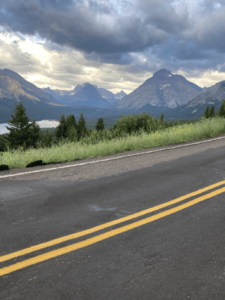
Helen Augare-Carlson felt confused when she first heard the land acknowledgement of her alma mater, the University of Montana in Missoula. A Blackfeet educator, Augare expected a recognition of the relationships the Salish and Kalispel and the university have with the land the university now stands on. Instead, the statement declares that the land the university occupies is the traditional territory of the Salish and Kalispel people. When she read the acknowledgement, she was left wanting more. She wanted the land acknowledged.
Thousands of years. This is how long the Blackfeet have lived on the land we, descendants of settler-colonizers, are bicycling through. Settlers stole this land 200 years ago from the Blackfeet people. In other places, the United States government and white settlers shoved Indigenous people onto fragmented parcels of land. On Day 22 of our trip, we rode along the eastern edge of the Badger-Two Medicine, a sacred place, central to many Blackfeet origin stories.
Unlike many tribes, the relationship the Blackfeet have with the place they live now goes back thousands of years, because their reservation is on the land they are from. As the land changes—as winters become harsher, summers drier, fires more intense—they compare the changes to ancient stories.
“Talking about climate change is key to our observations of the land. Our stories talk about when this once was flooded and was a shallow ocean, not once, but many times. They tell us of a time when the earth was on fire,” Helen Augare-Carlson said. These stories are ancient, they are stories that tell of “energy bringing molecules together and why does matter matter.” These stories are proof of the deep connection the Blackfeet hold with the land.
Blackfeet “territory” was previously a large part of Montana. Augare-Carlson explained when she uses “territory” or “own,” she doesn’t mean them in the Western sense of property ownership; she means that the Blackfeet moved across the land, along with the Salish and Kalispel tribes. Now, the Blackfeet people are far flung.
Because the Blackfeet Reservation encompasses land the Blackfeet people have lived on for thousands of years, there is a deep relationship between the tribe and the land. In UM’s statement, Augare-Carlson was looking for recognition that the university also grew from the soil and spirit of a place, from the land. She was looking for recognition of human-land relationships.
The closer the earth gets to catastrophic climate change, the more important it becomes to recognize how human health and society are intertwined with the earth’s health and complex systems. Land acknowledgements aren’t just about the relationship between groups of humans, although the U.S.’s history of committing genocide and stealing land must be part of the conversation. Statements must look at how we interact with the earth.
Augare-Carlson described how the Blackfeet believe they were put on this part of the earth to take care of it for the future generations. She feels proper land acknowledgements would remind us that we have to really care about the earth we’re on. We have to take stock of the food chains surrounding us, every little intricate fiber of the earth we stand on. What are our human relationships? How do the relationships we have to other humans impact the land? What kinds of relationships do we have with the flora and fauna near us? Helen Augare-Carlson showed me these are the kinds of questions begging to be fulfilled by land acknowledgements.
Seneca Norvell is a student at St. Olaf College in Northfield, Minnesota, where she is majoring in Studio Art.